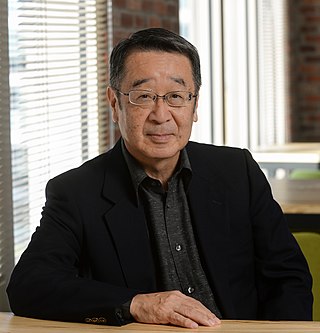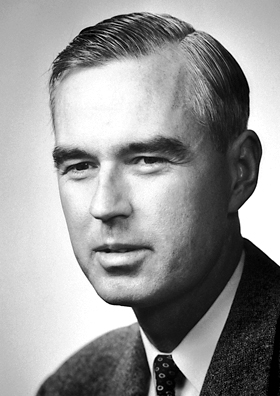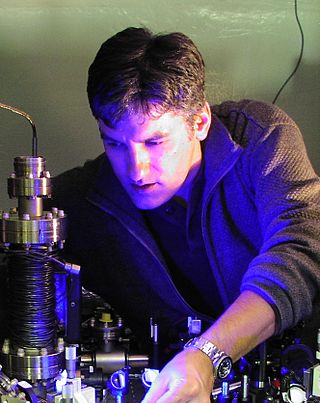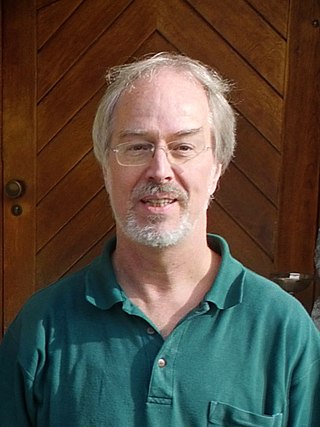
In quantum mechanics, Schrödinger's cat is a thought experiment that illustrates a paradox of quantum superposition. In the thought experiment, a hypothetical cat may be considered simultaneously both alive and dead, while it is unobserved in a closed box, as a result of its fate being linked to a random subatomic event that may or may not occur. This thought experiment was devised by physicist Erwin Schrödinger in 1935 in a discussion with Albert Einstein to illustrate what Schrödinger saw as the problems of the Copenhagen interpretation of quantum mechanics.

In atomic physics and chemistry, an atomic electron transition is a change of an electron from one energy level to another within an atom or artificial atom. It appears discontinuous as the electron "jumps" from one quantized energy level to another, typically in a few nanoseconds or less.

Laser cooling includes a number of techniques where atoms, molecules, and small mechanical systems are cooled with laser light. The directed energy of lasers is often associated with heating materials, e.g. laser cutting, so it can be counterintuitive that laser cooling often results in sample temperatures approaching absolute zero. Laser cooling relies on the change in momentum when an object, such as an atom, absorbs and re-emits a photon. For an ensemble of particles, their thermodynamic temperature is proportional to the variance in their velocity. That is, more homogeneous velocities among particles corresponds to a lower temperature. Laser cooling techniques combine atomic spectroscopy with the aforementioned mechanical effect of light to compress the velocity distribution of an ensemble of particles, thereby cooling the particles.
This is a timeline of quantum computing.

The quantum Zeno effect is a feature of quantum-mechanical systems allowing a particle's time evolution to be slowed down by measuring it frequently enough with respect to some chosen measurement setting.
Quantum optics is a branch of atomic, molecular, and optical physics dealing with how individual quanta of light, known as photons, interact with atoms and molecules. It includes the study of the particle-like properties of photons. Photons have been used to test many of the counter-intuitive predictions of quantum mechanics, such as entanglement and teleportation, and are a useful resource for quantum information processing.
Quantum Darwinism is a theory meant to explain the emergence of the classical world from the quantum world as due to a process of Darwinian natural selection induced by the environment interacting with the quantum system; where the many possible quantum states are selected against in favor of a stable pointer state. It was proposed in 2003 by Wojciech Zurek and a group of collaborators including Ollivier, Poulin, Paz and Blume-Kohout. The development of the theory is due to the integration of a number of Zurek's research topics pursued over the course of 25 years, including pointer states, einselection and decoherence.

A trapped-ion quantum computer is one proposed approach to a large-scale quantum computer. Ions, or charged atomic particles, can be confined and suspended in free space using electromagnetic fields. Qubits are stored in stable electronic states of each ion, and quantum information can be transferred through the collective quantized motion of the ions in a shared trap. Lasers are applied to induce coupling between the qubit states or coupling between the internal qubit states and the external motional states.
Cavity quantum electrodynamics is the study of the interaction between light confined in a reflective cavity and atoms or other particles, under conditions where the quantum nature of photons is significant. It could in principle be used to construct a quantum computer.

David Jeffrey Wineland is an American Nobel-laureate physicist at the National Institute of Standards and Technology (NIST) physics laboratory. His work has included advances in optics, specifically laser-cooling trapped ions and using ions for quantum-computing operations. He was awarded the 2012 Nobel Prize in Physics, jointly with Serge Haroche, for "ground-breaking experimental methods that enable measuring and manipulation of individual quantum systems".

Yoshihisa Yamamoto is the director of Physics & Informatics Laboratories, NTT Research, Inc. He is also Professor (Emeritus) at Stanford University and National Institute of Informatics (Tokyo).
The Kastler–Brossel Laboratory, located in Paris, France, is a research laboratory specializing in fundamental physics of quantum systems. Founded in 1951 by Alfred Kastler and Jean Brossel, it is a joint research unit operated by the French National Centre for Scientific Research (CNRS), the École normale supérieure, the Sorbonne University and the Collège de France.

The Einstein Prize for Laser Science was a recognition awarded by the former Society for Optical and Quantum Electronics and sponsored by the Eastman Kodak Company. The prize, awarded in the 1988–1999 period, consisted of a 3-inch brass medal including Einstein's image and a depiction of a two-level transition including the A and B coefficients. Recipients of the prize include:

Christopher Roy Monroe is an American physicist and engineer in the areas of atomic, molecular, and optical physics and quantum information science, especially quantum computing. He directs one of the leading research and development efforts in ion trap quantum computing. Monroe is the Gilhuly Family Presidential Distinguished Professor of Electrical and Computer Engineering and Physics at Duke University and is College Park Professor of Physics at the University of Maryland and Fellow of the Joint Quantum Institute and Joint Center for Quantum Computer Science. He is also co-founder and chief scientist at IonQ, Inc.
Ramsey interferometry, also known as the separated oscillating fields method, is a form of particle interferometry that uses the phenomenon of magnetic resonance to measure transition frequencies of particles. It was developed in 1949 by Norman Ramsey, who built upon the ideas of his mentor, Isidor Isaac Rabi, who initially developed a technique for measuring particle transition frequencies. Ramsey's method is used today in atomic clocks and in the S.I. definition of the second. Most precision atomic measurements, such as modern atom interferometers and quantum logic gates, have a Ramsey-type configuration. A more modern method, known as Ramsey–Bordé interferometry uses a Ramsey configuration and was developed by French physicist Christian Bordé and is known as the Ramsey–Bordé interferometer. Bordé's main idea was to use atomic recoil to create a beam splitter of different geometries for an atom-wave. The Ramsey–Bordé interferometer specifically uses two pairs of counter-propagating interaction waves, and another method named the "photon-echo" uses two co-propagating pairs of interaction waves.

Gerhard Rempe is a German physicist, Director at the Max Planck Institute of Quantum Optics and Honorary Professor at the Technical University of Munich. He has performed pioneering experiments in atomic and molecular physics, quantum optics and quantum information processing.
Jean-Michel Raimond is a French physicist working in the field of quantum mechanics.
Guo Guangcan is a Chinese physicist. He is a professor at the University of Science and Technology of China (USTC) and Peking University (PKU). He works on quantum information, quantum communication and quantum optic. He is an academician of the Chinese Academy of Sciences and The World Academy of Sciences.

Cavity optomechanics is a branch of physics which focuses on the interaction between light and mechanical objects on low-energy scales. It is a cross field of optics, quantum optics, solid-state physics and materials science. The motivation for research on cavity optomechanics comes from fundamental effects of quantum theory and gravity, as well as technological applications.

Michel Devoret is a French physicist and F. W. Beinecke Professor of Applied Physics at Yale University. He also holds a position as the Director of the Applied Physics Nanofabrication Lab at Yale. He is known for his pioneering work on macroscopic quantum tunneling, and the single-electron pump as well as in groundbreaking contributions to initiating the fields of circuit quantum electrodynamics and quantronics.













